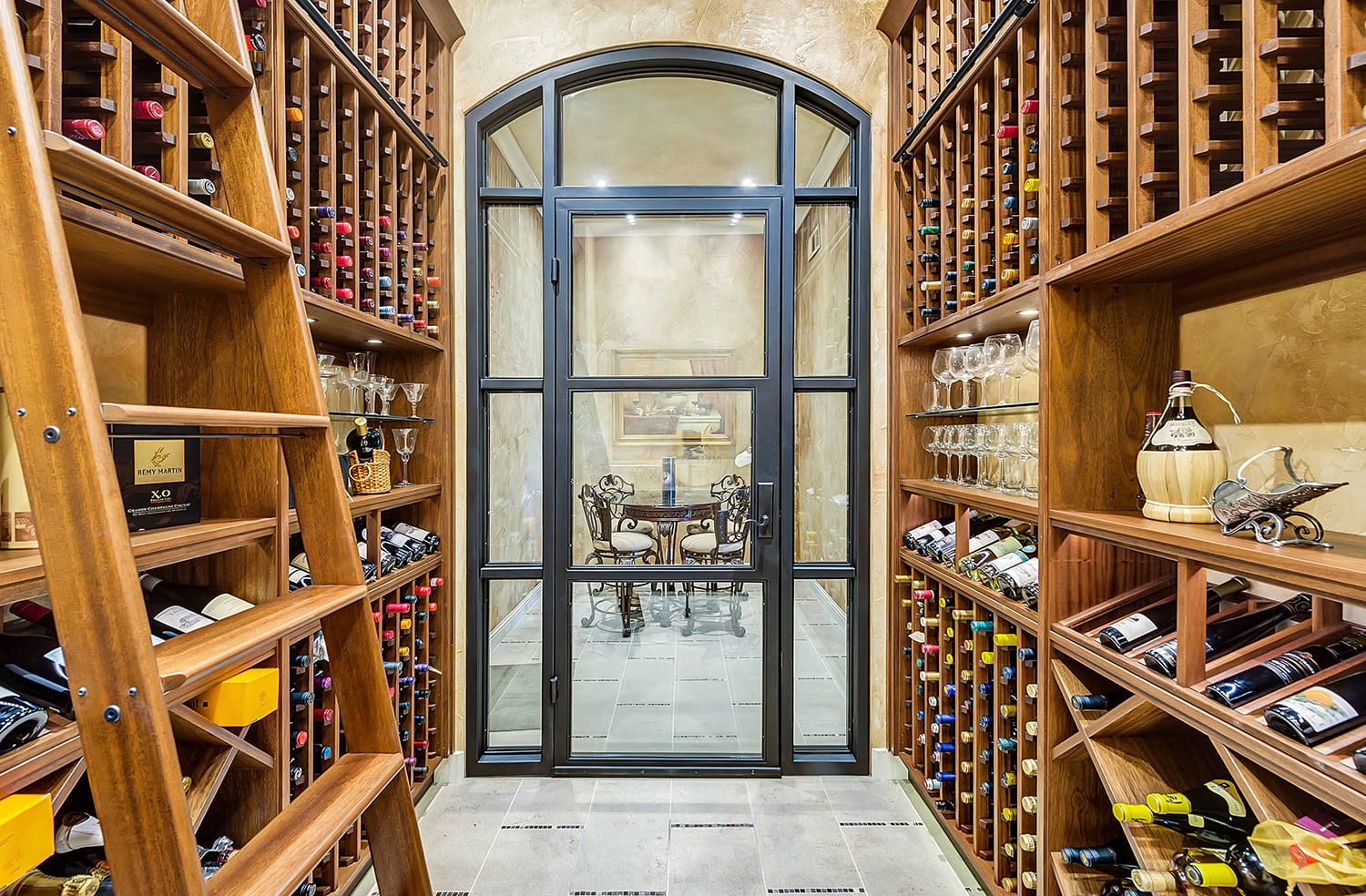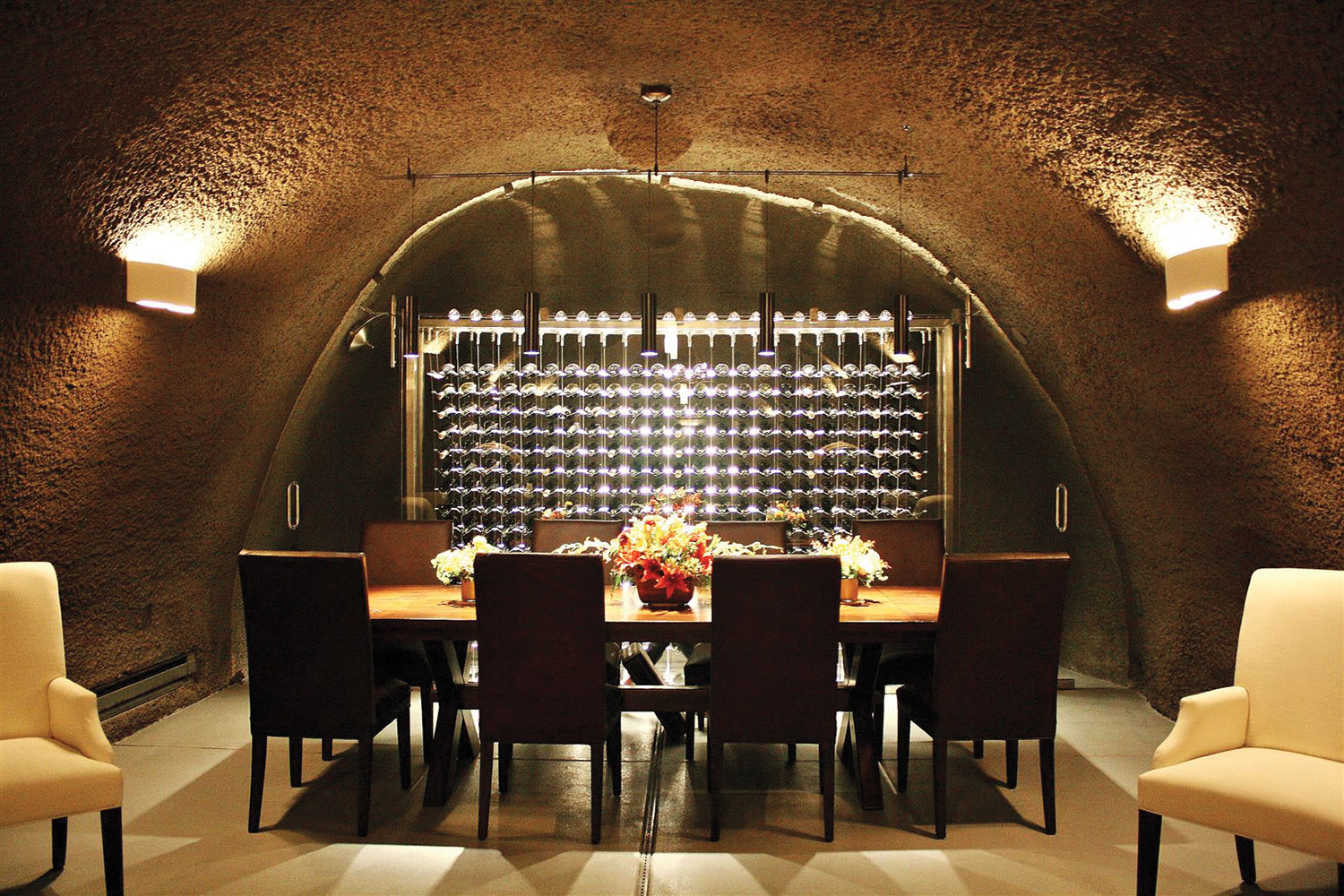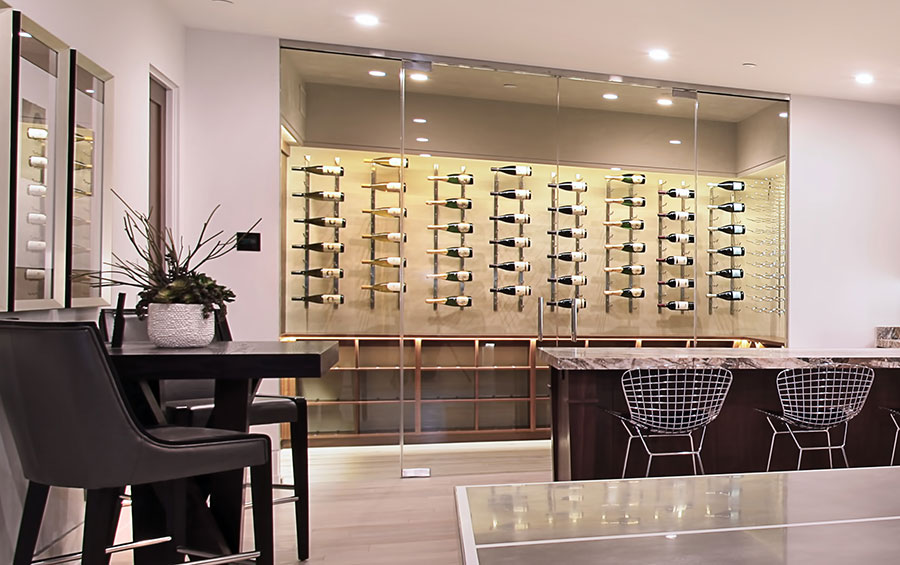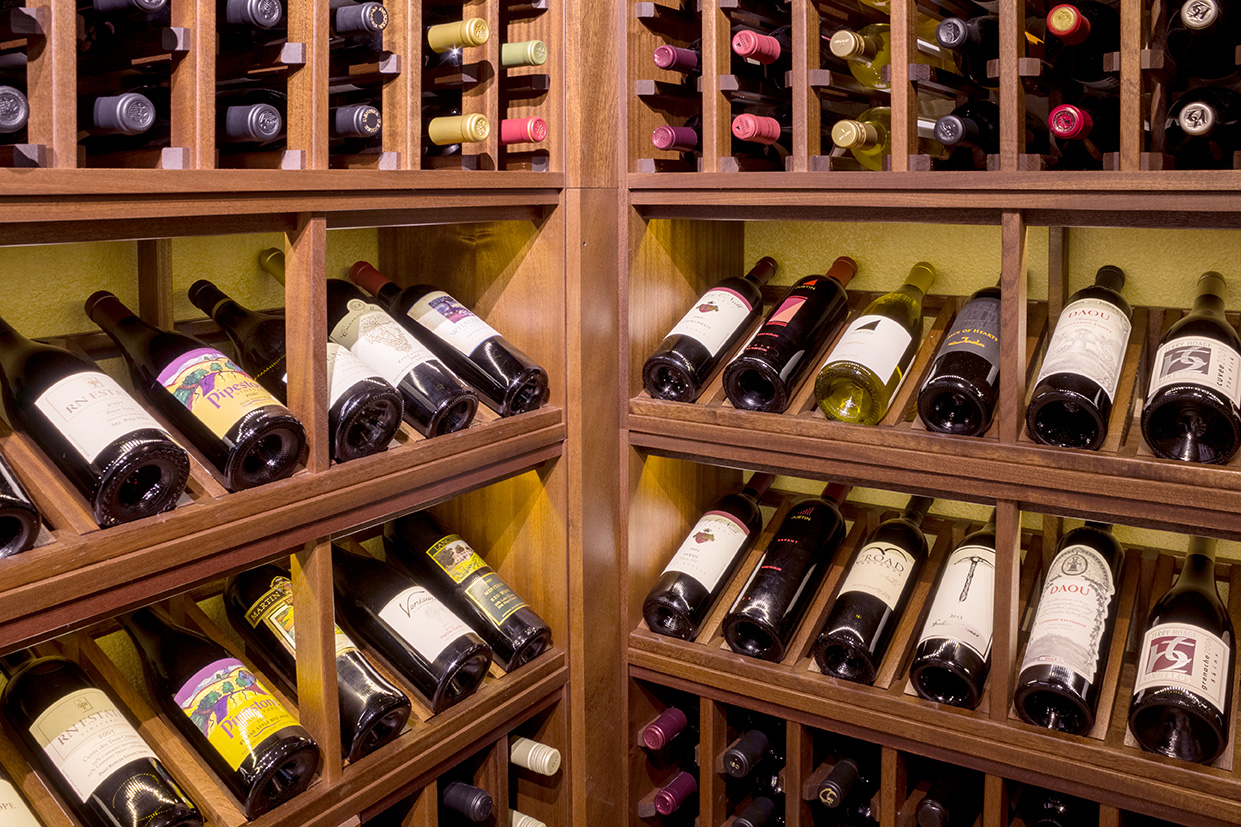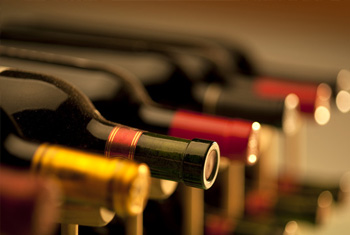
Many wine collectors–and homeowners–dream of building a wine cellar in their home. It’s no wonder–what better way to increase the value of your home, and show off your sophistication to your friends! Plan ahead and follow some basic rules, and you’ll soon be sipping wine from the wine cellar of your dreams.
1. Where do I start?
Before building a wine cellar, ask yourself why you are building it. Will the cellar be purely for storing wine, or will it also be used for entertaining and displaying your wine collection? If your wine cellar will be used purely for storing wine, then you should opt for unstained wood racks made from pine and metal, which sell for as little as $2 per bottle. You can skip the “display” racking–you’ll get increased bottle capacity for the same price.
If you want to create an area where you can proudly display your wine and entertain guests, consider common upgrades like islands, archways, tabletops and waterfalls, which will add elegance and personality to your wine cellar. Also consider using premium hardwoods like redwood or mahogany, which can be stained in a variety of finishes, to match the décor or achieve a distinctive look.
2. How should wine be stored?
The ideal conditions for storing and aging wine are 55-60˚F and 60-70% relative humidity. If you don’t have a space where these conditions exist naturally, you’ll need to create a controlled environment to store your wine. Ideally, wine will be stored in darkness, with minimal vibration and disturbance as it ages.
Wine Coolers: Most wine coolers are temperature-controlled, and do a great job of maintaining wine at proper serving temperatures. Wine coolers are ideal for short-term storage of wine. However, most wine coolers have temperature variations that are too wide for proper storage of fine wine, and few maintain proper humidity conditions for long-term storage and aging.
Wine Cabinets: One option is to purchase a refrigerated wine cabinet. Generally, wine cabinet bottle capacities range from 100 to 700 bottles, and are available in a variety of styles. At the cheaper end of the spectrum, you can purchase a wine cabinet with metal wine racks and a basic cooling system that will last for a couple of years. At the higher end of the spectrum, you will find fine furniture pieces with all-wood racking, premium wood finishes and the best wine cellar cooling units.
Wine Cellars: Another option is to build a temperature-controlled wine cellar. Though more expensive than wine cabinets, standalone wine cellars can be designed any number of ways, with many options to store a variety of wine bottles, stemware and accessories. Wine cellars must be constructed with adequate insulation, a moisture barrier and an airtight seal (see below for more information).
3. What are the critical components in a wine cellar?
The three most important aspects of a quality wine cellar are: insulation, vapor barrier and airtight seal.
- Insulation – we recommend a minimum of R12, and R19 if possible. To the extent the cellar shares an exterior wall, R30 insulation is preferable for that wall. Since most walls are constructed with 2” x 4” studs, you should be able to use 2 x 1½” bats (3” total) with R6 per inch, or R18 total insulation.
- Moisture barrier – it is imperative to use a vapor barrier when constructing a wine cellar. The most common vapor barrier is 6 mil poly sheeting (also called Visqueen), which should be wrapped around the entire wine cellar on the outside (ie the warm side) of the insulation.
- Airtight seal – when the wine cellar door is closed, the wine cellar should have an airtight seal. For example, the door should have weather-stripping and a door-sweep to prevent air from entering the cellar when the door is closed.
4. Concrete walls are great for wine cellars, right?
Unfortunately, concrete walls provide poor insulation and are very porous. The R-value of an uninsulated, 8-inch-thick basement wall built using normal-weight concrete is 1.35. By doubling the thickness of the wall to 16 inches, the R-value only increases by 0.50. Given its porous nature, concrete doesn’t do a good job of keeping moisture out of the wine cellar If you have concrete walls in your cellar, you’ll need to attach a layer of poly coating and then rigid foam insulation to create a moisture barrier and adequate insulation for those walls.
5. How will glass walls, windows or doors impact the wine cellar?
Glass has low R-value, and therefore provides poor insulation in wine cellars. The R-value of “thermal double pane glass” is around 3. This means that you’ll need to account for the glass when you calculate the thermal load of your wine cellar. Calculating the thermal load is the best way to size the cooling unit for your wine cellar. Be careful about relying on the “rated capacity” estimates from the cooling unit manufacturers–their assumptions used may be very different from the conditions in your wine cellar, which is why you need to calculate the thermal load.
6. How do I select a wine cooling unit?
There is a direct correlation between price and performance when it comes to selecting a wine cooling system:
- Through-the-wall cooling systems are the most cost-effective and easiest to install. They are shipped fully-charged and ready-to-use in a self-enclosed case. The downside of through-the-wall cooling units is that they take up space inside the cellar, and noise from the cooling unit can be heard inside and outside the wine cellar. They also require a hole in the wall to fit the cooling unit, and sufficient space on BOTH sides of the wall so that proper ventilation can occur. Cost: $1,000 – $3,500
- Split cooling systems are built so that some of the components are located outside the wine cellar, and some of the components are located inside the cellar. The two sets of components always will be connected by two refrigerant lines, which need to be charged and braised by a qualified professional in the field. In addition, power and drain lines may need to be setup by the professional. The advantage of split systems is that the condensing unit can be located in a remote location, which mitigates noise from the compressor, and split systems don’t require having a big hole in the wall. The disadvantage is that split cooling systems require professional installation, which is expensive. Cost: $5,000 and up
- Ducted cooling systems, where the entire cooling unit is located remotely and cold air is ducted into the wine cellar, are the most expensive wine cooling systems. Their main advantages are that the wine cellars won’t be subject to noise from the cooling unit, and commercial systems can be serviced by most HVAC professionals. In addition, space in wine cellar can be maximized for wine storage, because the cooling unit doesn’t take any space inside the cellar. The disadvantage of ducted systems is that they require professional installation, and the vents must be designed and constructed into the building structure, so that retrofits can be prohibitively expensive. Cost: $3,000 – $6,000 plus installation.
7. How do I select wine racks?
The most popular types of wine racks are as follows:
- Individual bottle storage: each bottle is cradled in its own cell, either single or double deep. Difference size cells are designed to accommodate various types of bottles, such as Bordeaux, Burgundy/Champagne, Magnums and splits.
- Diamond Bin Storage: Diamond bins provide bulk storage with flair. Bins provide maximum flexibility because they accommodate any size bottle, but they’re best suited for long-term storage because bottles at the bottom are difficult to access, and bottles must be handled carefully because they are resting on each other.
- Case Storage: Wood and cardboard case wine racks are designed to hold wine bottles in their original cases. Some case storage comes with sliding shelves for easy access. Make sure to specify wood vs. cardboard cases, because wood cases are wider/shorter and cardboard cases are narrower/taller.
- Tabletops: With individual bottle or bin storage below, tabletops provide excellent spaces for opening bottles and pouring wine. Tabletops can be made from matching woods and/or stone surfaces to match your design. Tabletops also provide space to store and display accessories like stemware, decanters and bottle openers
8. What about my large-format bottles?
Have you ever noticed the difference in size between Bordeaux/Cabernet and Burgundy/Pinot bottles? For most wine cellars, individual bottle storage for 750ml bottles will make up a large part of your wine racks, so you’ll want to make sure that the slot sizes are wide enough to accommodate today’s large-format bottles. Generally, 3 ¾” is wide enough for most Bordeaux, Burgundy and many Champagne bottles. If you have a lot of Magnum or split bottles, you’ll need dedicated storage for each of these bottle types. Same goes for larger bottles like Double Magnums, Jeroboams, etc.
9. Are wine racks kit ok, or do I need custom wine racks?
Wine rack kits are offered with a variety of configurations and options, so in many cases, it’s possible to attain a custom look while paying a mass-produced price. First, decide if you want your wine racks to go all the way to the ceiling, or is it Ok if they stop at six feet. Then, think about which configurations, options and wood species you want in your wine cellar. Wine rack kits offer many–but not all–of the configurations, options, stains and wood species offered by custom wine racks, so if you have flexibility, you’ll probably save money.
10. How much will it cost?
The cost to build a wine cellar will include some or all of the following components:
- Construction – wine cellars need proper insulation and moisture barriers to create an airtight environment inside the cellar. Framing for the cooling unit and structural support in the floor also must be included in the construction of the wine cellar. Cost: Variable depending on the size of the wine cellar
- Wine Cooling Unit – constant temperatures ranging from 55-60 degrees and humidity ranging from 50-70% are ideal conditions for wine storage and aging. Wine cooling units are designed to maintain ideal conditions, and are offered primarily in through-the-wall, split, or ducted systems. Cost (including installation): $1,000 – $10,000
- Wine Racks – choices range from kits to complete custom solutions, and vary in cost based on the number of bottles, amount of customization, type of wine racks, type of wood and choice of upgrades and options. Metal racks also are a low-cost option, especially for bulk racking. For individual bottle storage, metal wine racks are sub-optimal because they can tear bottle labels and, over time, may lose their form and crumple under the weight of the wine bottles. Cost: $2.00 – $20 per bottle
- Wine Cellar Door – Exterior-grade insulated door must provide an airtight seal and high thermal insulation. Cost: $600 – $3000
- Wine Cellar Floor – From tile to concrete to cork wood, just about any floor surface will work as long as it matches your décor and aesthetic design. Keep in mind that softer surfaces (like cork wood) will be more forgiving if/when you drop a bottle, and sealed surfaces (like tile) are easiest to clean and repel stains. Cost: $3 – $15 psf
- Accessories – Lighting, wood paneling and artwork are examples of accessories that add finishing touches and create unique wine cellars, but add cost to the project. Cost: Variable
Call one of our IWA Design Center experts if you have any questions, we are happy to discuss your potential cellar (800) 527-4072 x1.
